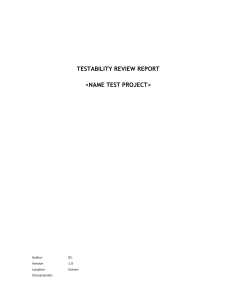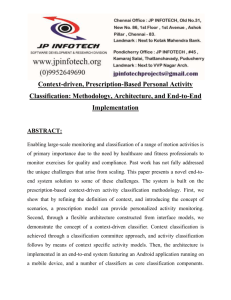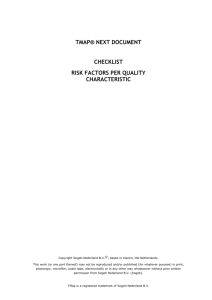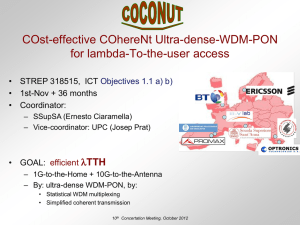Checklist E2E chance_of_failures
advertisement
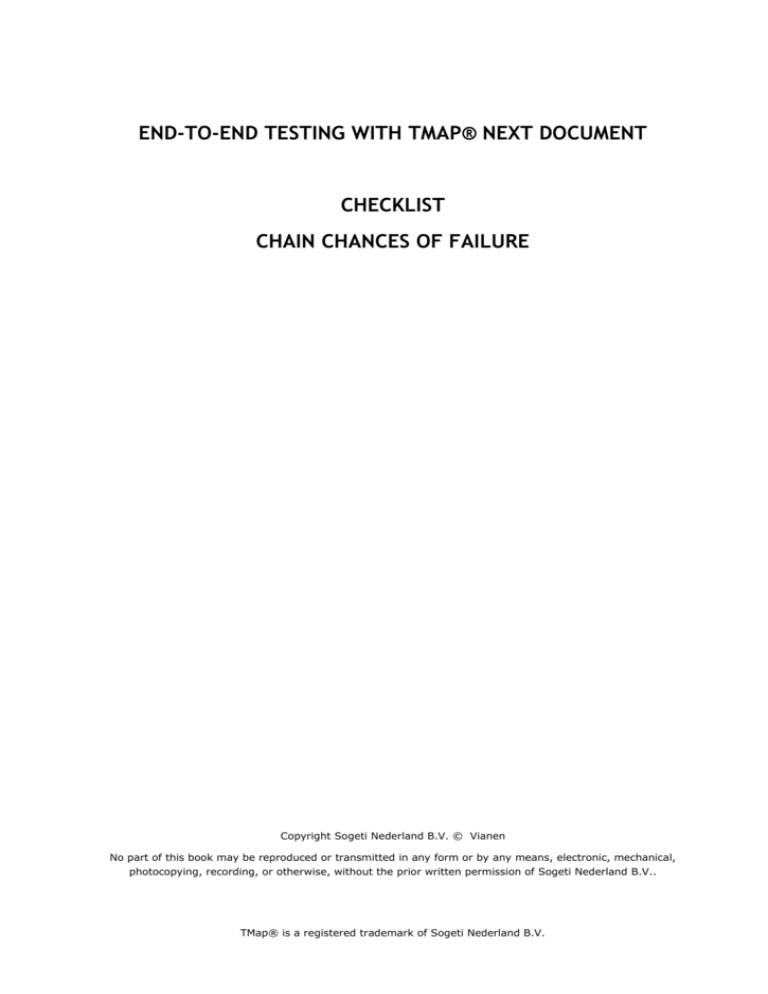
END-TO-END TESTING WITH TMAP® NEXT DOCUMENT CHECKLIST CHAIN CHANCES OF FAILURE Copyright Sogeti Nederland B.V. © Vianen No part of this book may be reproduced or transmitted in any form or by any means, electronic, mechanical, photocopying, recording, or otherwise, without the prior written permission of Sogeti Nederland B.V.. TMap® is a registered trademark of Sogeti Nederland B.V. End-to-End Testing with TMap® Next CHAIN CHANCES OF FAILURE CHECKLIST This checklist lists chain chances of failure. Use the checklist to prepare and execute the chain risk analysis. Cf. chapter 4, section 4.2. Architecture, architecture-related Capacity of systems and interfaces (sizing) is not aligned. Complex layering in architecture. Applications used are so-called generic systems, are used by multiple processes. An error occurs in multiple processes. No backup and restore facilities (for restoring) across the entire chain, making this facility impracticable in the event of incidents. Chain performance too low so that processes do not have the required lead times. New architecture. Online and batch systems mixed up. Fallback not organised. Lots of legacy. Increased use of scarce, costly computer resources: CPU, network, database channels (IO time). Version differences between components. Management/Administration (technical, functional) Administrator of system components not known/involved in the chain. Administrators have limited insight into the use of the system. Inadequate knowledge management. Lots of maintenance (releases). Lots of different administrator parties involved. Responsibility for maintenance with a department other than development. Building Modification in system within the organisation may lead to problems further down the chain but outside the organisation. Agile development does not coincide with idea of chain. Contracts with sub-contractors specified inadequately in terms of quality requirements and testability of components/sub-deliveries. No or limited configuration management across the chain. No direct contact between the developers of the various applications and the chain components. No testable software parts (increments) are delivered. No/limited understanding of the technical limitations (potential bottlenecks) of the system components in the process. Generic system components that are used in lots of separate processes; a fault in such a system causes multiple processes to fail. Geographic distribution of the development team has a negative impact on communication. High diversity of technologies used between systems. Large number of interfaces between the systems. Chain risks underestimated by working with small increments that are then taken into production without chain risk analysis (and end-to-end test). Legacy systems need to be adapted for integration into the chain. Sogeti Nederland B.V 1 End-to-End Testing with TMap® Next Multiple system changes, test basis quality inadequate, increasingly if version management is lacking. Methods have not been recorded or are not aligned (maturity of the process). No standard naming convention for components, or naming may cause confusion. New (non-proven) technology deployed. Use of unknown and/or small sub-contractor. No maintenance-friendly programming languages. Inadequate (or inadequately expandable) infrastructure. Unprocessed data are overwritten, e.g. in temporary files when the communication process is rebooted or backups are restored. Multiple sub-contractors are responsible for delivering system components. Design and processes, functional aspects Application (parts) have been designed by multiple (international) parties; units do not match (cm/inches, date format, etc). Audit trail too complex / too many failures. The automation solution does not support the process (completely). Business-critical systems have an impact on less business-critical systems. Modification of the meaning of data (fields). The requirements of logical access control are not taken into account when supplying data (to third parties) and external data communication. Complex services with long service life, there is no total overview. Means of verification (checks) (e.g. at the end of the process) not in scope. Means of verification (checks) not set up, origin of data cannot be traced. Data synchronisation in the process (associated checks) generates errors. Sub-chains have different levels of supervision and regulations; the entire chain is impossible to control/verify. Database interfacing means that the combination of data is covered by the Personal Data Protection Act (WBP) (a new chain emerges). Inadequate relationship between AO design and systems in the chain (AO not in line with chain functionality). No (information) access path analysis in design. No security to protect against denial-of-services attacks. No verification of duplicate processing of data between sub-systems (e.g. in case of rebooting after calamity or restoring backup). No data contracts or agreements (no protocol for the interface); the SLAs do not cover intra-organisation interfaces. No use of encryption or sub-processes that do not use it (the overall process is not secure). No integral design (also known as chain design). No insight into the total chain (what is the path of the dataflows?). No insight into the total technical chains (what is the path of the pipelines? What temporary files, batches, interfaces, service windows?). No insight into current and future use. No facilities to ensure that the process can continue to the greatest possible extent in some form or another in the event of serious failures or calamities. Systems in the process have been tested for stand-alone fallback; not to ensure their correct operation in the process after fallback. Data exchange via networks (OSI, TCP/IP) does not comply with applicable (inter)national standards or company standards. Interface design modifications are made without consultation with other stakeholders, which leads to mutual frustration and lack of cooperation. Sogeti Nederland B.V 2 End-to-End Testing with TMap® Next Interface designs are not adequately agreed upon with the various stakeholders. There is (very) limited knowledge of the systems with which interfaces exist. The quality of the designs is inadequately in line with the process. Data mix results in security problems (privacy). The mix of information systems is too complex (produces uncertainties, coherence is not clear). Mix of custom and packages. Transaction monitoring and logging is not (fully) set up. Incorrect use of fields results in errors further down the chain (may also occur in impacted processes!). Unchecked access opportunities, administrator manipulations generate errors in the chain. The design and realisation of system components in the chain occur in separate processes, with little or no communication. The administrators have not specified adequate requirements/acceptance criteria or are not familiar with the process (or part thereof). Inadequately rebootable process or unfamiliarity with the consequences of a reboot. Process scheduling not set up correctly (chain performance too low or errors occur because batches start up too early). Process scheduling cannot be set up as a chain process. Processes are not aligned (the data are incomplete or the correct data are not exchanged). Redundant data storage (lots of data are stored in the organisation's 'own' system) due to inadequate interfacing. The suitability of requirements for chains has not been verified (are they in line with the chain design?). The requirements are not realistic, overblown. Too much functionality is demanded (this is often the case when ERP systems are implemented). Inadequate documentation, no version management of documentation. Systems in contact with the outside world, e.g. via a public network (the internet), are interfaced with internal systems – a new chain emerges. Systems and sub-processes outside the manageable domains. Systems contain too many workarounds; the impact of the links on the chains is unknown. Too many function points; the process is too complex. Increasing use of system use (more users, more operations). Slow error reports generate process errors that are discovered too late further on in the process. Rework is executed across multiple systems. Many modifications of generic system components. Many expanded systems. Many different platforms (technical). Different generations of software intermingle. Working without a technical or functional architecture or not complying with the architecture (exceptions to the rule). Workarounds in legacy components turn process changes into complex operations. Project and test management-related The parties that manage the system differ too much (chain partners and vision do not match). Sub-chains are too distant in terms of location or time; the communication between projects is inadequate. Sogeti Nederland B.V 3 End-to-End Testing with TMap® Next Unilateral editing of source data (no chain-wide communication). Owners of system components in the chain are unknown/uncommitted. End users of system components in the chain are unknown/uncommitted. Entry/exit criteria for end-to-end testing not implemented adequately. Components are delivered that cause too many errors. The FAT has not been done; the possibly low quality of the software results in delays/longer lead time/adjustment of the end-to-end test. Fault situations have not been tested (often the case in end-to-end testing! Sunny day scenarios are tested and people are satisfied that these exit the chain successfully). No adequate supervision of compliance with the design; risk of design faults resulting in costly rework and delays. No separate project phase for chain integration. No commitment on the part of executives. No commitment on the part of specific parties (demonstrating in practice that it can be done). No clear business case or the business case exists for just one party (the rest of the stakeholders do not understand the importance). No data ownership. Intake not done correctly; the components cannot be tested or do not collaborate. AS-IS and SHOULD-BE positions unknown for increments or releases, increasing the risk of non-testable increments. The chain has only been tested from a technical perspective; the process does not operate efficiently. Lack of chain awareness: there is no joint interest or it is not perceived as such. End-to-end testing is perceived as ‘nice to have’ and is the first victim if the project runs past the deadline. Non-testable SHOULD-BE situation; testing is impossible and chain risks are not eliminated. The planning is not realistic. Executing the end-to-end test as the last test means delays, so end-to-end testing is cancelled. The planning/detailed planning of the various sub-systems is not aligned and/or does not take account of the end-to-end test. Portability (large variation of platforms) in client testing and such. Process not split up into sub-chains (or cannot be split up). The project tries to realise too much in one go and thereby becomes impossible to test. Projects are not executed as part of a programme; there is no (release) consultation. Risks and dependencies are not adequately aligned. There is an impact on secondary chains. The relevance of the project becomes less clear in the execution phase; commitment is lost. Software vendors do not involve the test manager when planning the subdeliveries. Test environments cannot be reserved exclusively for the end-to-end test; basic files / test results are manipulated in the course of the end-to-end test. Test environments are not representative (not sufficiently production-like); the end-to-end test does not cover the high risks. Test environments have been polluted; the end-to-end test is delayed due to the many error reports and interruptions. The division of tasks, responsibilities and rights between stakeholders is inadequate. Sogeti Nederland B.V 4 End-to-End Testing with TMap® Next Cultural differences between the various parties; the differing visions clash during end-to-end testing. Working under high time pressure (end-to-end testing in the last project phase; end-to-end test is executed in part or not at all). Sogeti Nederland B.V 5

